Mathematical Modeling of the Operation of an Expander-Generator Pressure Regulator in Non-Stationary Conditions of Small Gas Pressure Reduction Stations
Abstract
:1. Introduction
2. Materials and Methods
2.1. Functional Chart
- (a)
- stabilization of the pressure drop before and after the expander, which ensures the consistent speed of the expander rotor, but requires maintaining pressure at the outlet of the GPRS by an additional PR (RF patent No. 2620624, Figure 1a);
- (b)
- stabilization of the pressure at the outlet of the reduction station directly by the expander control system, without a separate stabilization loop for stabilizing the frequency of rotor rotation (RF patent No. 2662784, Figure 1b).
- (a)
- of the pressure drop before and after the expander 6;
- (b)
- of the pressure at the outlet of the expander pressure regulator 1, determined by the sensors 9.
- (a)
- they are sent to the PR 14, in which pressure is finally reduced to the required value;
- (b)
- they are sent to the consumer pipeline through the outlet shut-off valves 12.
2.2. Expander Pressure Reduction Factors and Parameters
- gas parameters: —average gas compressibility factor; —individual gas constant; —specific heat capacity at constant pressure; —density; —adiabatic exponent;
- flow inputs: —gas temperature and pressure; —mass flow through the reduction station; —functions of gas pressure and flow seasonality;
- parameters of pipes and fittings, including the control valve: —inner dimension area of the expander exhaust and starter passages, consumer pipeline, and control valve; —friction factor; —local resistance coefficient; —consumer pipeline length;
- environment parameter: —environmental temperature;
- expander physical and geometrical parameters: —number of working rotor blades; —expander rotor radius; —injection zone end angle; —blade material density; —blade friction coefficient against the stator; —the equivalent moment of inertia, load, and expander rotor inertia;
- control system parameters: —gain factors of integral and proportional terms; , —required values of GPRS outlet pressure and rotor rate of rotation.
2.3. Logical Conditions
- from gas injection in the expander;
- “part” of rotation resistance (RM1) at the end of the turn.
- the moment from gas expansion in closed space between blades No. 1 and No. 2;
- another “part” of rotation resistance (RM2).
2.4. Accounting of Gas Compressibility
2.5. Differential Equation System
3. Results and Discussion
- reduction of mass gas consumption by consumers by 30%;
- increase in mass gas consumption by consumers by 30%;
- decrease in upstream pressure at the GPRS by 5%;
- increase in upstream pressure at the GPRS by 5%.
- natural gas in the gas distribution system is the driest in the entire gas supply system, since it is the closest to the consumer and has been dehydrated many times on its way;
- gas leaves the EGR under a low overpressure of about 0.05 kPa, which prevents hydrate formation;
- volumetric expanders are low-maintenance and can deal reasonably well with gas flow irregularities;
- the mass flow rate of gas through small GPRSs (GCUs) is quite low, and therefore does not have a high refrigeration content; therefore, due to heat exchange, it rather quickly heats up from the environment.
4. Conclusions
Author Contributions
Funding
Institutional Review Board Statement
Informed Consent Statement
Conflicts of Interest
Abbreviations
| GPR | a gas pressure reduction station |
| ECP | an electrochemical protection |
| GCU | a gas control unit |
| PR | a pressure regulator |
| EGU | an expander-generator unit |
| EGR | an expander-generator regulator |
| SSV | a safety shut-off valve |
| SRV | a safety relief valve |
| PI | a proportional-integral |
| PID | a proportional-integral-derivative |
Nomenclature
| , | compressibility factor coefficients |
| elementary work of gas in the discharge chamber | |
| work performed by gas during expansion | |
| blade thickness | |
| specific heat capacity at constant pressure | |
| DM | discharge moment |
| valve seat diameter | |
| inner diameter of consumer pipeline | |
| elemental area of the volume of the working cavity | |
| eccentricity of the rotor relative to the stator | |
| the rate of valve orifice opening | |
| EM | expansion moment |
| local resistance coefficient | |
| local resistance coefficient of the inlet passage | |
| local resistance coefficient of the exhaust passage | |
| inner dimension area of the expander exhaust and starter passages, consumer pipeline, and control valve | |
| number of working rotor blades | |
| rotor turning point | |
| injection zone end angle | |
| area of the internal section of the launch channel of the expander | |
| inlet passage cross-sectional area | |
| full flow area of the control valve | |
| mass flow through the reduction station | |
| mass flow through the expander | |
| gas mass flow from the pipeline in the expander discharge chamber | |
| gas mass flow through the exhaust chamber | |
| gas flow through the control valve | |
| gas flow through the pressure reduction station | |
| height of the part of blade No. 1 protruding from the rotor | |
| height of the part of blade No. 2 protruding from the rotor | |
| height of the part of blade No. 3 protruding from the rotor | |
| blade height | |
| full valve spindle travel | |
| average height of the protruding part of the blade | |
| integral link of the regulation law | |
| the equivalent moment of inertia, load, and expander rotor inertia | |
| adiabatic exponent | |
| functions of gas pressure and flow seasonality | |
| gain factors of integral and proportional terms | |
| , , | control coefficients |
| expander coefficient of leaking | |
| consumer pipeline length | |
| rotor (blade) axial length | |
| mass of gas in the exhaust chamber | |
| the mass of the protruding part of the blade | |
| the algebraic sum of moments in the discharge, expansion, and exhaust chambers | |
| the moment of friction of the blades against the stator | |
| the generator moment of resistance | |
| the coefficient of gas flow through the valve | |
| expander power | |
| expander efficiency factor | |
| pressure in the discharge chamber | |
| pressure in the expansion chamber | |
| pressure in the exhaust chamber | |
| ,, | pseudo-critical pressure and pressure reduced to pseudo-critical conditions |
| gas density under standard conditions | |
| blade material density | |
| gas limit pressure in the discharge chamber | |
| , | the required output pressure and instantaneous output pressure at the GPRS |
| nominal pressure of the gas-using equipment | |
| atmosphere pressure | |
| proportional link of the regulation law | |
| GPRS inlet gas pressure | |
| required value of GPRS outlet pressure | |
| GPRS outlet gas pressure | |
| pressure in the volume under consideration | |
| expander rotor radius | |
| radius of the center of gravity of the protruding part of the blade | |
| RM | rotation resistance moment |
| stator inner radius | |
| individual gas constant | |
| environmental temperature | |
| , | pseudo-critical temperature and temperature reduced to pseudo-critical conditions |
| temperature in the discharge chamber | |
| temperature in the expansion chamber | |
| temperature in the exhaust chamber | |
| gas temperature in the control valve | |
| temperature in the cavity of the flow connection behind the expander regulator | |
| GPRS inlet gas temperature | |
| GPRS outlet gas temperature | |
| temperature in the volume under consideration | |
| internal energy of the gas in the discharge chamber | |
| gas internal energy in the expansion chamber | |
| gas internal energy in the exhaust chamber | |
| gas kinematic viscosity at standard conditions | |
| constant speed of opening or closing of the control valve by an electric actuator with a positioner | |
| cavity volume | |
| expander rotor rate of rotation | |
| amount of heat which is supplied to gas in the discharge chamber | |
| specific quantity of heat which the gas gives off in the exhaust chamber | |
| , | the required frequency and instantaneous frequency of the expander rotation |
| angle between adjacent blades | |
| output signal | |
| compressibility factor | |
| compressibility factor of gas in the discharge chamber | |
| compressibility factor of gas in the expansion chamber | |
| compressibility factor of gas in the exhaust chamber | |
| the gas-compressibility factor in the cavity | |
| the coefficient of friction of the blades against the stator | |
| friction factor |
Appendix A
| Parameter | Symbols | Value | Dimension | |
|---|---|---|---|---|
| Stator inner radius | 0.0233 | m | ||
| Expander rotor radius | 0.02 | m | ||
| Eccentricity of the rotor relative to the stator | 0.00328 | m | ||
| Number of blades in the expander | For modeling | 6 | pieces | |
| For checking the adequacy of the model | 5 | |||
| Blade length | 0.05 | m | ||
| Blade thickness | 0.005 | m | ||
| Blade height | 0.0131 | m | ||
| Injection zone end angle | For modelling | 1.25664 | rad | |
| For checking the adequacy of the model | 1.0472 | |||
| Angle between adjacent blades | For modelling | 1.25664 | rad | |
| for checking the adequacy of the model | 1.0472 | |||
| Blade material density | 1300 | kg/m3 | ||
| Coefficient of correction of sliding friction force according to the results of the experiment | - | 0.575 | dim | |
| Coefficient of friction of the blades against the stator | 0.2 | dim | ||
| Adiabatic exponent | Natural gas | 1.3 | dim | |
| Air | 1.4 | |||
| Gas density at standard conditions | Natural gas | 0.73 | kg/m3 | |
| Air | 1.2 | |||
| Heat capacity at constant pressure | Natural gas | 3200 | J/kg·K | |
| Air | 1005 | |||
| Individual gas constant | Natural gas | 520 | J/kg·K | |
| Air | 287 | |||
| Gas kinematic viscosity at standard conditions | Natural gas | 15.06·10−6 | Pa·s | |
| Air | 14.3·10−6 | |||
| Gas temperature at the inlet to the GPRS | 293 | K | ||
| Expander coefficient of leaking | 0.65 | dim | ||
| Expander efficiency factor | 0.85 | % | ||
| Exhaust passage cross-sectional area | 0.00008 | m2 | ||
| Inlet passage cross-sectional area | 0.00008 | m2 | ||
| Atmosphere pressure | 100,000 | Pa | ||
| Local resistance coefficient of the inlet passage | 20 | dim | ||
| Local resistance coefficient of the exhaust passage | 20 | dim | ||
| Gas flow through valve coefficient | 0.8 | dim | ||
| Inner diameter of consumers pipeline | 0.05 | m | ||
| Time of complete valve reset | - | 17 | s | |
| Consumer pipeline length | 50 | m | ||
| Full flow area of the control valve | 0.000176 | m2 | ||
Appendix B
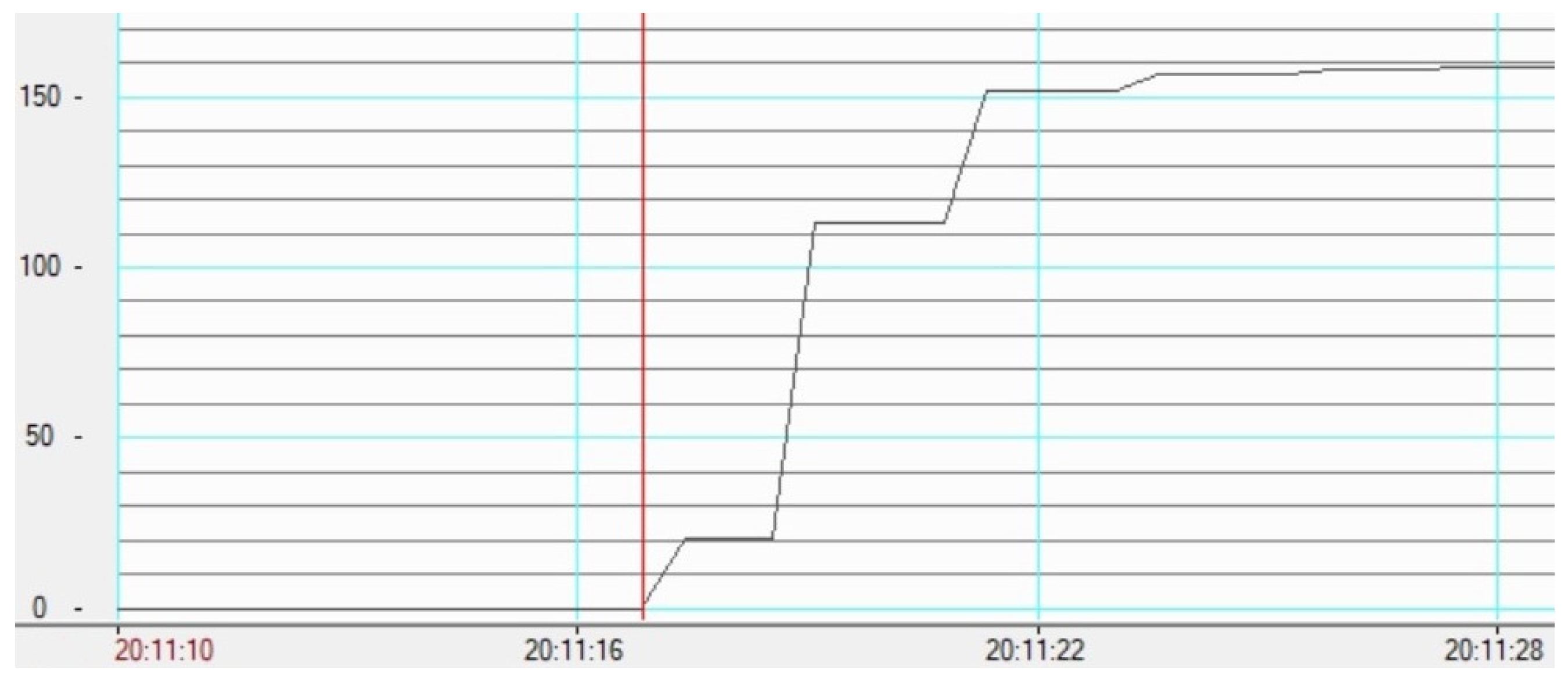
References
- AO “Gazprom Gazoraspredelenie”. Available online: http://gazoraspredelenie.gazprom.ru (accessed on 1 November 2020).
- Kostowski, W.J.; Usón, S. Comparative evaluation of a natural gas expansion plant integrated with an IC engine and an organic Rankine cycle. Energy Conv. Manag. 2013, 75, 509–516. [Google Scholar] [CrossRef]
- Kargaran, M.; Arabkoohsar, A.; Hagighat-Hosini, S.J.; Farzaneh-Kord, V. The second law analysis of natural gas behavior within a vortex tube. Therm. Sci. 2013, 17, 1079–1092. [Google Scholar] [CrossRef]
- Sheikhnejad, Y.; Simões, J.; Martins, N. Energy harvesting by a novel substitution for expansion valves: Special focus on city gate stations of high-pressure natural gas pipelines. Energies 2020, 13, 956. [Google Scholar] [CrossRef] [Green Version]
- Kashtanova, I.I. The economic mechanism for the implementation of energy conservation policies. Notes Min. Inst. 2009, 184, 218–224. [Google Scholar]
- Voronina, Y.V.; Iseeva, L.I. Analysis of the effectiveness of state regulation in the fuel and energy complex of Russia. Notes Min. Inst. 2009, 182, 177–180. [Google Scholar]
- Kostowski, W. The possibility of energy generation within the conventional natural gas transport system. Stroj. J. Theory Appl. Mech. Eng. 2010, 52, 429–440. [Google Scholar]
- He, T.B.; Ju, Y.L. Design and optimization of natural gas liquefaction process by utilizing gas pipeline pressure energy. Appl. Therm. Eng. 2013, 57, 1–6. [Google Scholar] [CrossRef]
- Gord, M.F.; Hashemi, S.; Sad, M. Energy destruction in Iran’s natural gas pipe line network. Energy Explor. Exploit. 2007, 25, 393–406. [Google Scholar] [CrossRef]
- Badami, M.; Modica, S.; Portoraro, A. A biofuel-based cogeneration plant in a natural gas expansion system: An energetic and economic assessment. Appl. Therm. Eng. 2017, 118, 52–61. [Google Scholar] [CrossRef]
- Farzaneh-Gord, M.; Sadi, M. Enhancing energy output in Iran’s natural gas pressure drop stations by cogeneration. J. Energy Inst. 2008, 81, 191–196. [Google Scholar] [CrossRef]
- Leusheva, E.L.; Morenov, V.A. Development of combined heat and power system with binary cycle for oil and gas enterprises power supply. Neftyanoe Khozyaystvo-Oil Ind. 2017, 7, 104–106. [Google Scholar] [CrossRef]
- Rahman, M.M. Power generation from pressure reduction in the natural gas supply chain in Bangladesh. J. Mech. Eng. 2010, 41, 89–95. [Google Scholar] [CrossRef] [Green Version]
- Danieli, P.; Carraro, G.; Lazzaretto, A. Thermodynamic and economic feasibility of energy recovery from pressure reduction stations in natural gas distribution networks. Energies 2020, 13, 4453. [Google Scholar] [CrossRef]
- Fokin, G.A. Development and creation of autonomous power plants of low power with an expansion turbine. Gas Turbine Technol. 2010, 1, 10. [Google Scholar]
- Mohod, S.W.; Aware, M.V. A STATCOM-control scheme for grid connected wind energy system for power quality improvement. IEEE Syst. J. 2010, 4, 346–352. [Google Scholar] [CrossRef]
- Hossain, M.J.; Pota, H.R.; Ramos, R.A. Robust STATCOM control for the stabilisation of fixed-speed wind turbines during low voltages. Renew. Energy 2011, 36, 2897–2905. [Google Scholar] [CrossRef] [Green Version]
- Repin, L.A. Possibilities of using natural gas pressure energy at small gas distribution stations. Energosberezhenie 2004, 3, 34–39. [Google Scholar]
- Seresht, R.T.; Jalalabadi, H.K.; Rashidian, B. Retrofit of Tehran City Gate Station (C.G. S.No.2) by Using Turboexpander. In Proceedings of the ASME 2010 Power Conference, Chicago, IL, USA, 13–15 July 2010. [Google Scholar] [CrossRef]
- Taleshian, M.; Rastegar, H.; Askarian, H. Modeling and power quality improvement of grid connected induction generators driven by turbo-expanders. Int. J. Energy Eng. 2012, 2, 131–137. [Google Scholar] [CrossRef]
- Rastegar, S.; Kargarsharifabad, H.; Shafii, M.B.; Rahbar, N. Experimental investigation of the increasing thermal efficiency of an indirect water bath heater by use of thermosyphon heat pipe. Therm. Sci. 2020, 24, 4277–4287. [Google Scholar] [CrossRef]
- Arabkoohsar, A.; Machado, L.; Koury, R.N.N. Operation analysis of a photovoltaic plant integrated with a compressed air energy storage system and a city gate station. Energy 2016, 98, 78–91. [Google Scholar] [CrossRef]
- Arabkoohsar, A.; Farzaneh-Gord, M.; Deymi-Dashtebayaz, M.; Machado, L.; Koury, R.N.N. A new design for natural gas pressure reduction points by employing a turbo expander and a solar heating set. Renew. Energy 2015, 81, 239–250. [Google Scholar] [CrossRef]
- Schipachev, A.M.; Dmitrieva, A.S. Application of the resonant energy separation effect at natural gas reduction points in order to improve the energy efficiency of the gas distribution system. J. Min. Inst. 2021, 248, 253–259. [Google Scholar] [CrossRef]
- Xiong, Y.; An, S.; Xu, P.; Ding, Y.; Li, C.; Zhang, Q.; Chen, H. A novel expander-depending natural gas pressure regulation configuration: Performance analysis. Appl. Energy 2018, 220, 21–35. [Google Scholar] [CrossRef]
- Farzaneh-Gord, M.; Ghezelbash, R.; Sadi, M.; Moghadam, A.J. Integration of vertical groundcoupled heat pump into a conventional natural gas pressure drop station: Energy, economic and CO2 emission assessment. Energy 2016, 112, 998–1014. [Google Scholar] [CrossRef]
- Borelli, D.; Devia, F.; Lo Cascio, E.; Schenone, C. Energy recovery from natural gas pressure reduction stations: Integration with low temperature heat sources. Energy Convers. Manag. 2018, 159, 274–283. [Google Scholar] [CrossRef] [Green Version]
- Barbarelli, S.; Florio, G.; Scornaienchi, N.M. Developing of a small power turbine recovering energy from low enthalpy steams or waste gases: Design, building and experimental measurements. Therm. Sci. Eng. Prog. 2018, 6, 346–354. [Google Scholar] [CrossRef]
- Fokin, G.A. Methodology for the Creation of Autonomous Turbine Sources of Electrical Energy Using the Energy of Compressed Natural Gas for the Own Needs of the Gas Transmission System of Russia. Ph.D. Thesis, Peter the Great St. Petersburg Polytechnic University, St. Petersburg, Russia, 2015. [Google Scholar]
- Krizsky, V.; Aleksandrov, P.; Kovalskii, A.; Viktorov, S. Mathematical modelling of Electric and Magnetic Fields of main pipelines cathodic protection in electrically anisotropic media. E3S Web Conf. 2021, 225, 1–4. [Google Scholar] [CrossRef]
- Karasevich, V.A.; Chernykh, A.S.; Yakovlev, A.A. Prospects for the use of autonomous energy sources in the transportation and distribution of gas. Sci. J. Russ. Gas Soc. 2016, 1, 59–61. [Google Scholar]
- Diao, A.; Wang, Y.; Guo, Y.; Feng, M. Development and application of screw expander in natural gas pressure energy recovery at city gas station. Appl. Therm. Eng. 2018, 142, 665–673. [Google Scholar] [CrossRef]
- Cipollone, R.; Contaldi, G.; Sciarretta, A.; Tufano, R.; Villante, C. A theoretical model and experimental validation of a sliding vane rotary compressor. In Proceedings of the International Compressor Engineering Conference at Purdue University, West Lafayette, IN, USA, 17–20 July 2006; 2006. [Google Scholar]
- Panarin, M.V.; Pakhomov, S.N.; Vorobiev, N.Y.; Tsarkov, G.Y. Turbine Expander Control Device. Patent RF 2579301, 10 April 2016. [Google Scholar]
- Aksenov, D.T.; Aksenova, G.P. A Method for Sustainable Gas Supply by a Gas Distribution Station with an Energy Refrigeration Complex Using Overpressure Energy of Natural Gas to Generate Electricity and Cold, and a System for Implementing the Method. Patent RF 2346205, 10 February 2009. [Google Scholar]
- Pozivil, J. Use of expansion turbines in natural gas pressure reduction stations. Acta Montan. Slovaca 2004, 9, 258–260. [Google Scholar]
- Neseli, M.A.; Ozgener, O.; Ozgener, L. Energy and exergy analysis of electricity generation from natural gas pressure reducing stations. Energy Convers. Manag. 2015, 93, 109–120. [Google Scholar] [CrossRef]
- Turboexpanders. 2020. Available online: http://detander.com/turbodet/ (accessed on 1 November 2020).
- Zamyatin, E.; Voytyuk, I.; Zamyatina, E. Increasing the energy efficiency of an enterprise by point compensating of power quality distortions. E3S Web Conf. 2019, 140, 04010. [Google Scholar] [CrossRef] [Green Version]
- Zhemchugov, G.A.; Plekhanov, S.N. Regulation of turboexpander sources of electrical energy based on closed gas turbine circuits. Questions of Electromechanics. VNIIEM Proc. 2001, 100, 125–146. [Google Scholar]
- Chelaznov, A.A. State and prospects for the use of autonomous sources at the enterprises of OAO Gazprom. In Proceedings of the Meeting of NTC OAO Gazprom, Moscow, Russia; 2007. [Google Scholar]
- Zywica, G.; Kaczmarczyk, T.Z.; Ihnatowicz, E. A review of expanders for power generation in small-scale organic Rankine cycle systems: Performance and operational aspects. Proc. Inst. Mech. Eng. Part A J. Power Energy 2016, 230, 669–684. [Google Scholar] [CrossRef]
- Li, G.; Wu, Y.; Zhang, Y.; Zhi, R.; Wang, J.; Ma, C. Performance study on a single-screw expander for a small-scale pressure recovery system. Energies 2017, 10, 6. [Google Scholar] [CrossRef] [Green Version]
- Żywica, G.; Kaczmarczyk, T.; Ihnatowicz, E. Expanders for dispersed power generation: Maintenance and diagnostics problems. Trans. Inst. Fluid-Flow Mach. 2016, 131, 173–188. [Google Scholar]
- STO Gazprom 2-3.5-051-2006, Norms of Technological Design of Main Gas Pipelines; OOO “IRC Gazprom”: Moscow, Russian, 2006.
- Cipollone, R.; Bianchi, G.; Di Battista, D.; Contaldi, G.; Murgia, S. Mechanical energy recovery from low grade thermal energy sources. Energy Procedia 2014, 45, 121–130. [Google Scholar] [CrossRef] [Green Version]
- Tian, Y. Modeling and performance analysis of twin-screw expander under fluctuating operating conditions in steam pipeline pressure energy recovery applications. Energy 2017, 141, 692–701. [Google Scholar] [CrossRef]
- Donskoy, A.S. Mathematical Modeling of Processes in Pneumatic Drives; Publishing House of the Polytechnic University: St. Petersburg, Russia, 2009. [Google Scholar]
- Shonin, O.B.; Salov, R.A. Improvement of energy efficiency, reliability and environmental safety of power plants based on associated petroleum gas. J. Ecol. Eng. 2017, 18, 91–96. [Google Scholar] [CrossRef]
- Staskevich, N.L.; Sevyarynets, G.N.; Vigdorchik, D.Y. Handbook on Gas Supply and Gas Use; Nedra: Leningrad, Russia, 1990. [Google Scholar]


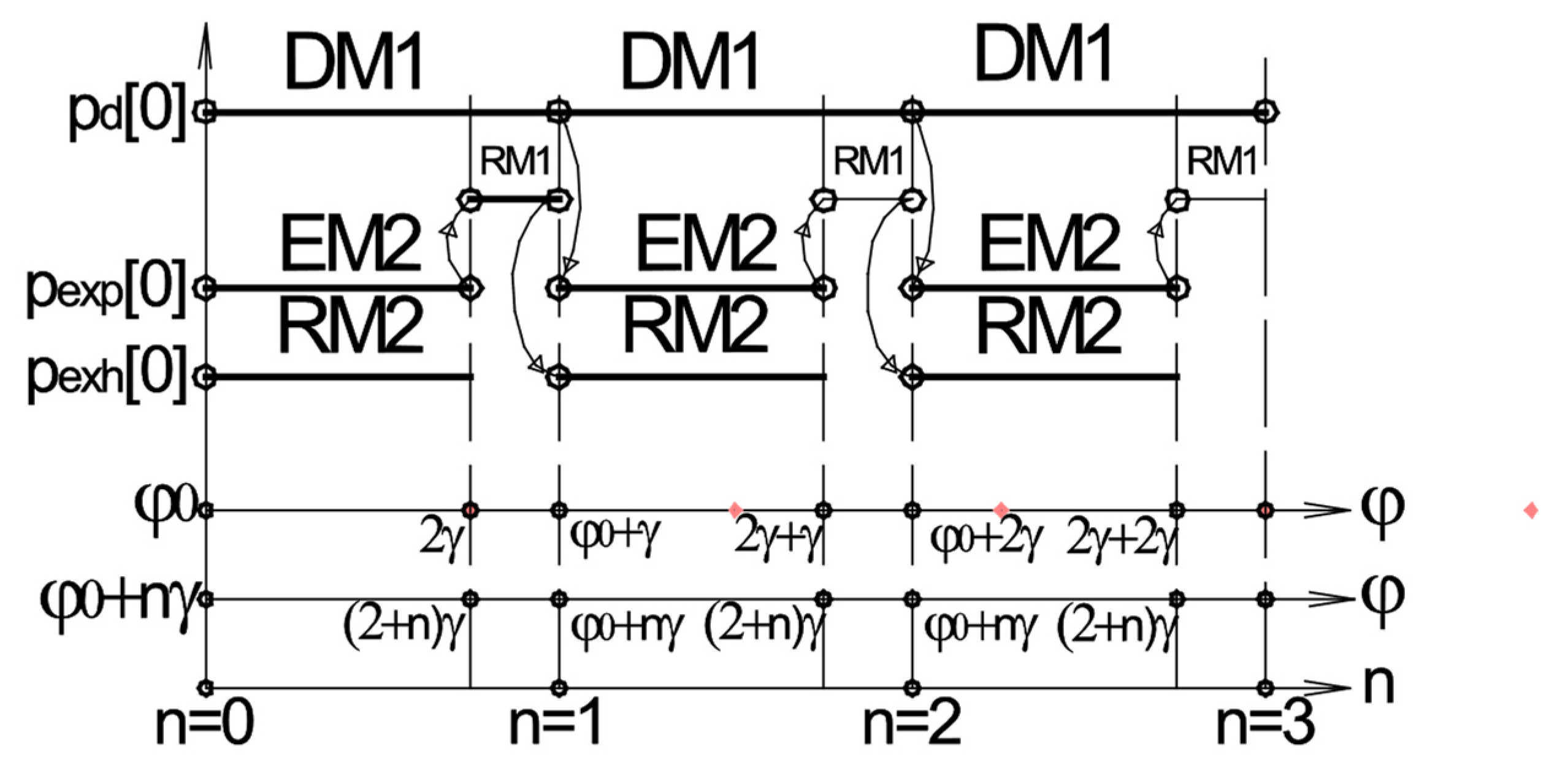
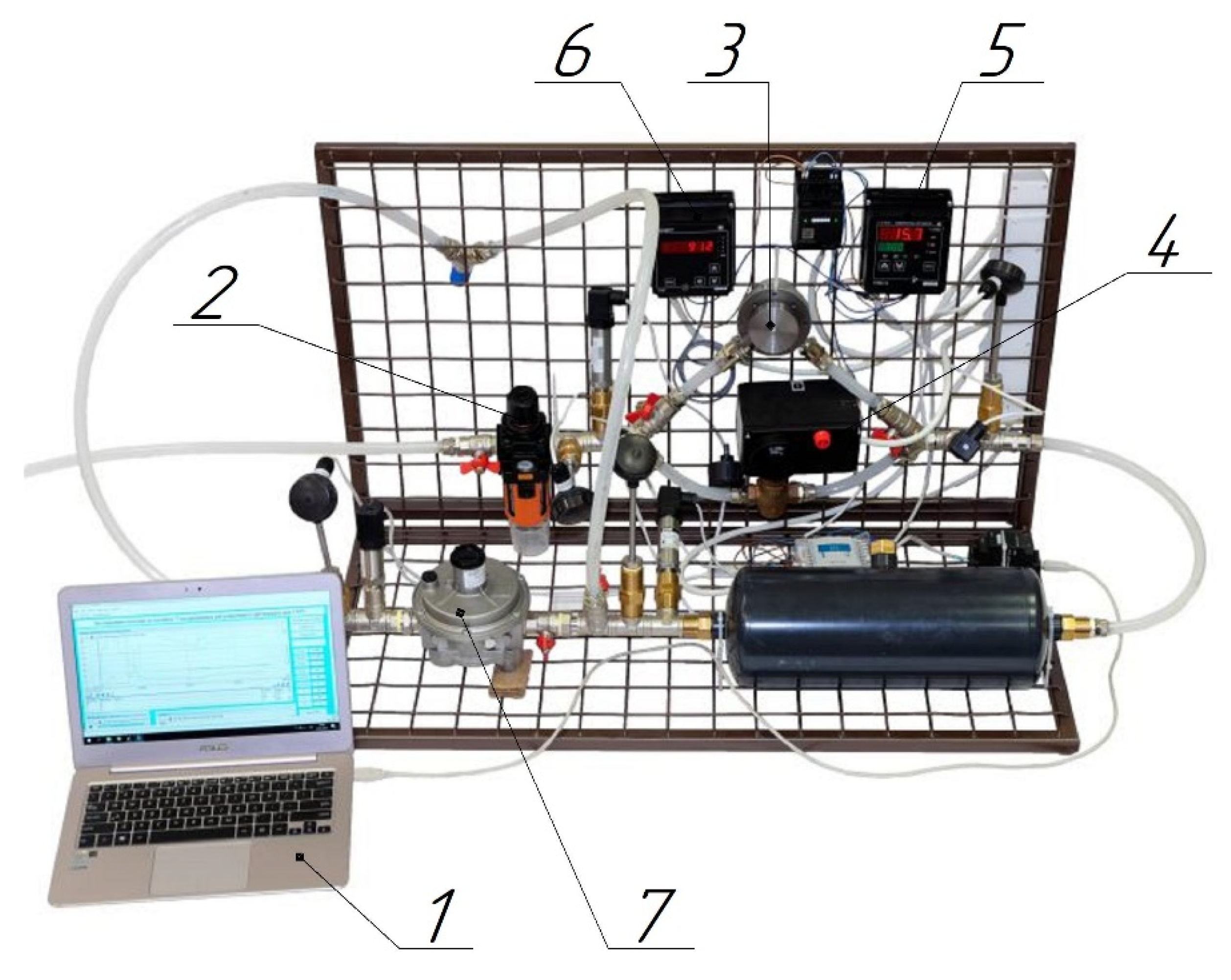
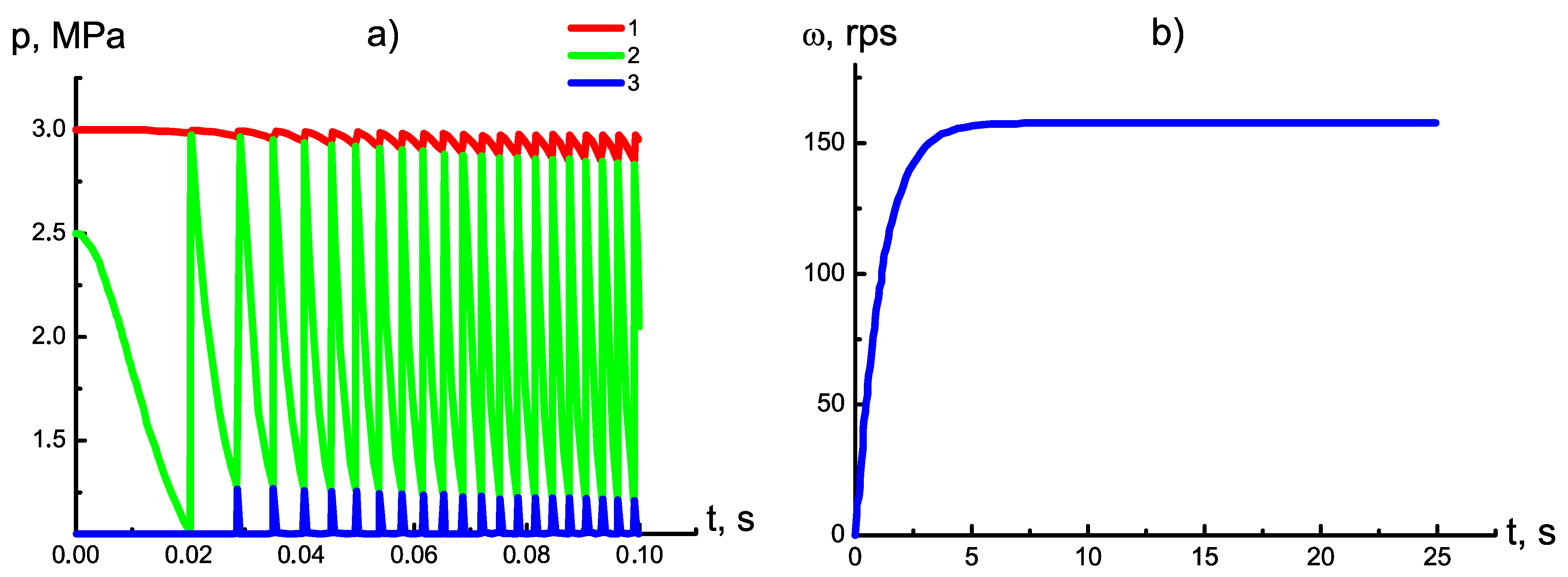

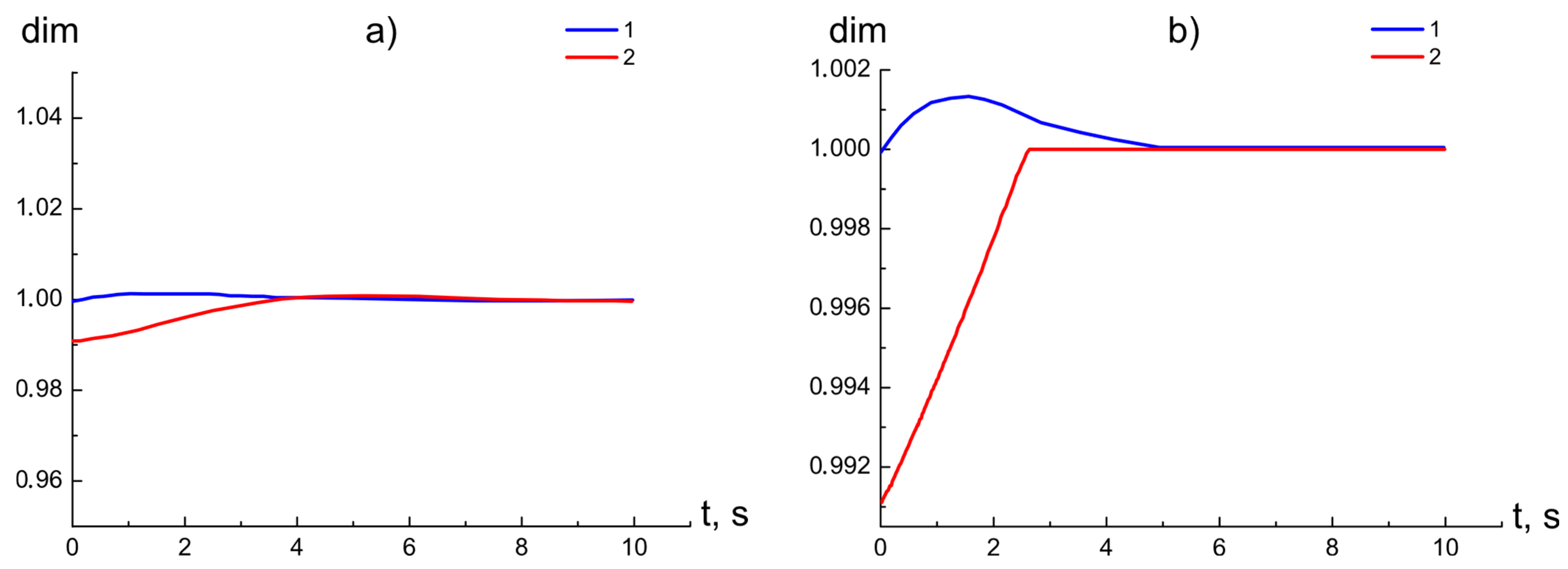


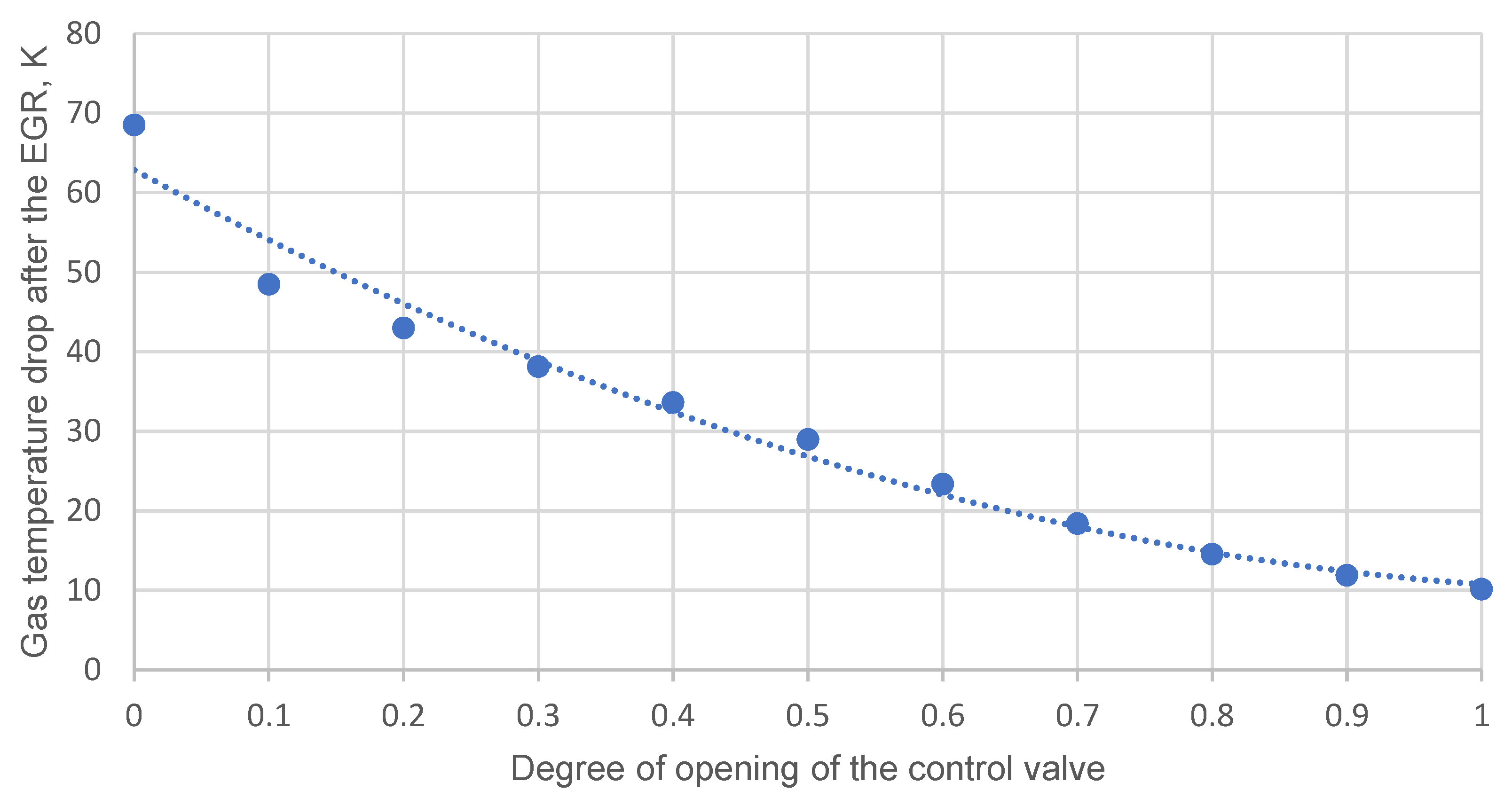
| Disturbance | Value, [%] | Pressure Stabilization | Frequency Stabilization | ||
|---|---|---|---|---|---|
| increase in pressure before the GPRS | 0.01 | 0.1 | 0.1 | 0.005 | |
| decrease in pressure before the GPRS | 0.01 | 0.1 | 0.5 | 0.5 | |
| increase in gas consumption | 0.01 | 0.1 | 0.25 | 0.05 | |
| reduction in gas consumption | 0.01 | 0.1 | 0.1 | 0.1 | |
| Disturbance | Value, [%] | Pressure Stabilization | Frequency Stabilization |
|---|---|---|---|
| Duration, s | Duration, s | ||
| increase in pressure before the GPR | +5 | 0.4 | 5.5 |
| decrease in pressure before the GPR | −5 | 0.5 | 9.2 |
| increase in gas consumption | +30 | 2.6 | 4.0 |
| reduction in gas consumption | −30 | 2.6 | 1.5 |
| average transition process time | 1.53 | 5.13 | |
Publisher’s Note: MDPI stays neutral with regard to jurisdictional claims in published maps and institutional affiliations. |
© 2022 by the authors. Licensee MDPI, Basel, Switzerland. This article is an open access article distributed under the terms and conditions of the Creative Commons Attribution (CC BY) license (https://creativecommons.org/licenses/by/4.0/).
Share and Cite
Belousov, A.E.; Ovchinnikov, E.S. Mathematical Modeling of the Operation of an Expander-Generator Pressure Regulator in Non-Stationary Conditions of Small Gas Pressure Reduction Stations. Mathematics 2022, 10, 393. https://doi.org/10.3390/math10030393
Belousov AE, Ovchinnikov ES. Mathematical Modeling of the Operation of an Expander-Generator Pressure Regulator in Non-Stationary Conditions of Small Gas Pressure Reduction Stations. Mathematics. 2022; 10(3):393. https://doi.org/10.3390/math10030393
Chicago/Turabian StyleBelousov, Artem Evgenevich, and Egor Sergeevich Ovchinnikov. 2022. "Mathematical Modeling of the Operation of an Expander-Generator Pressure Regulator in Non-Stationary Conditions of Small Gas Pressure Reduction Stations" Mathematics 10, no. 3: 393. https://doi.org/10.3390/math10030393






